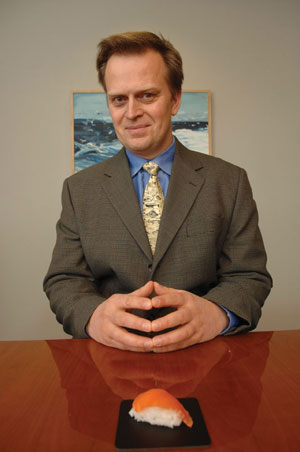 |
| Peter Tydemers with salmon sushi: western demand for sushi has made salmon a hot commodity. (Danny Abriel Photo) |
Fresh is better than frozen. Local food is better than food that comes from far away.
Popular thinking like this about how to improve food systems often misses the point, according to the results of a three-year global study of salmon production systems. HÂț» researcher Peter Tyedmers has found that the path toward sustainable salmon production is not what you might think.
Dr. Tyedmers, along with Astrid Scolz of Ecotrust in Portland, Oregon and Ulf Sonesson from the Swedish Institute for Food and Biotechnology in Gothenburg, has completed a three-year study of global production systems. The study finds that the world can achieve the maximum environmental benefits by focusing on improvements to certain aspects of production and distribution. Namely, frozen salmon is better for the environment than fresh because it requires less energy to get it from the ocean to your dinner plate.
The perception has long been that wild salmon is more expensive, sure, but as a sustainable food source itâs the better choice. But is it? It isnât when you look at the big picture, for example, by factoring in transportation issues.
âWhen people say, âI like local because of whom Iâm buying it from, freshness, whatever set of issues they want to construct around it,â thatâs great,â says Dr. Tyedmers. â(But) to say âitâs environmentally better,â thatâs making some big assumptions. One is that all other components of the supply chain are equal so it doesnât matter where your tomatoes are produced, whether itâs next door or in Mexico, all the inputs to that tomato productions are the same, all the environmental impacts are the same, the only difference is how far itâs traveled. And if that was the case, then itâs very sensible â buy local. But all my experience in food systems says things are almost never the same and we can illustrate that beautifully in our salmon work.â
Full life cycle approach
The authors note that this is the âworldâs first comprehensive global-scale look at a major food commodity from a full life cycle perspectiveâ and point out that âfish shouldnât fly, they should swim; container ships are by far the most efficient way to transport food, followed by rail systems.â
But itâs not only the itinerary salmon takes en route to the end of your fork thatâs at issue. There are, in fact a host of issues surrounding sustainability and salmon consumption.
âThe work we do steps back and says âhow do these systems contribute to these broad scale concerns, what are the drivers?ââ notes Dr. Tyedmers. âI like the idea of connecting where our food comes from and there are cultural reasons why we do that. It gets layered on with a lot of half baked or poorly thought through notions.â
He adds, âproducing farmed salmon by the same companies in four regions of the world, using the same technologies, the same species of salmon, you have markedly different broad-scale environmental impacts per unit of salmon produced that are driven entirely by differences in the feed; outwardly they look identical and so itâs very easy for me to speak to this issue of what are the environmental impacts of local versus distal?â He points out that the terms are often too loose, asking what defines âlocalâ? Is âlocalâ 100 kilometres away? Is âlocalâ New Brunswick?
While transport in many supply chains is a trivial, small fraction of the total impact of getting salmon to your plate, one has to look at their own behaviors as part of the overall mix. For example, if you make five individual trips to get your groceries for the week youâve negated all the other impacts of âgoing local.â Consumer behaviour remains an oft-overlooked but crucial part of the sustainability equation.
'We've culturally prioritized fresh'
Perhaps the biggest challenge is in cultural attitudes. Dr. Tyedmers points out that even if youâre not sure what youâre buying, or youâre not sure whether its better to buy organic farmed salmon or something else, if climate change is a concern, that simple choice of buying frozen filets at source over fresh, means youâve made an important distinction, one that has real climate change benefits.
Seafood is the most highly traded food commodity in terms of fractional volumes â almost 20 per cent of total global traded seafood is fresh and live, but this consists of many of the high end high ânicheâ products. Why? Well, put simply, weâve culturally prioritized fresh when it comes to seafood. âBut we donât prioritize fresh bacon,â points out Dr. Tyedmers. âWhen was the last time you were in a restaurant and you had the head waiter come up to your table in a nice high end restaurant and say, âoh our chops today, beautiful, fresh, two days from the farm. No one cares. No oneâs distinguishing fresh from frozen except in seafood because fresh seafood, if itâs not served well or itâs older, gets really yucky.
âBut thatâs a 19th and 20th century problem. We have fantastic freezing technologies now and great containerized freezer storage. We move large volumes of this stuff around but itâs a hangover of this kind of cultural prioritization.â He adds that in taste tests comparing fresh and frozen fish, the previously frozen fish comes out on top.
LINK:
